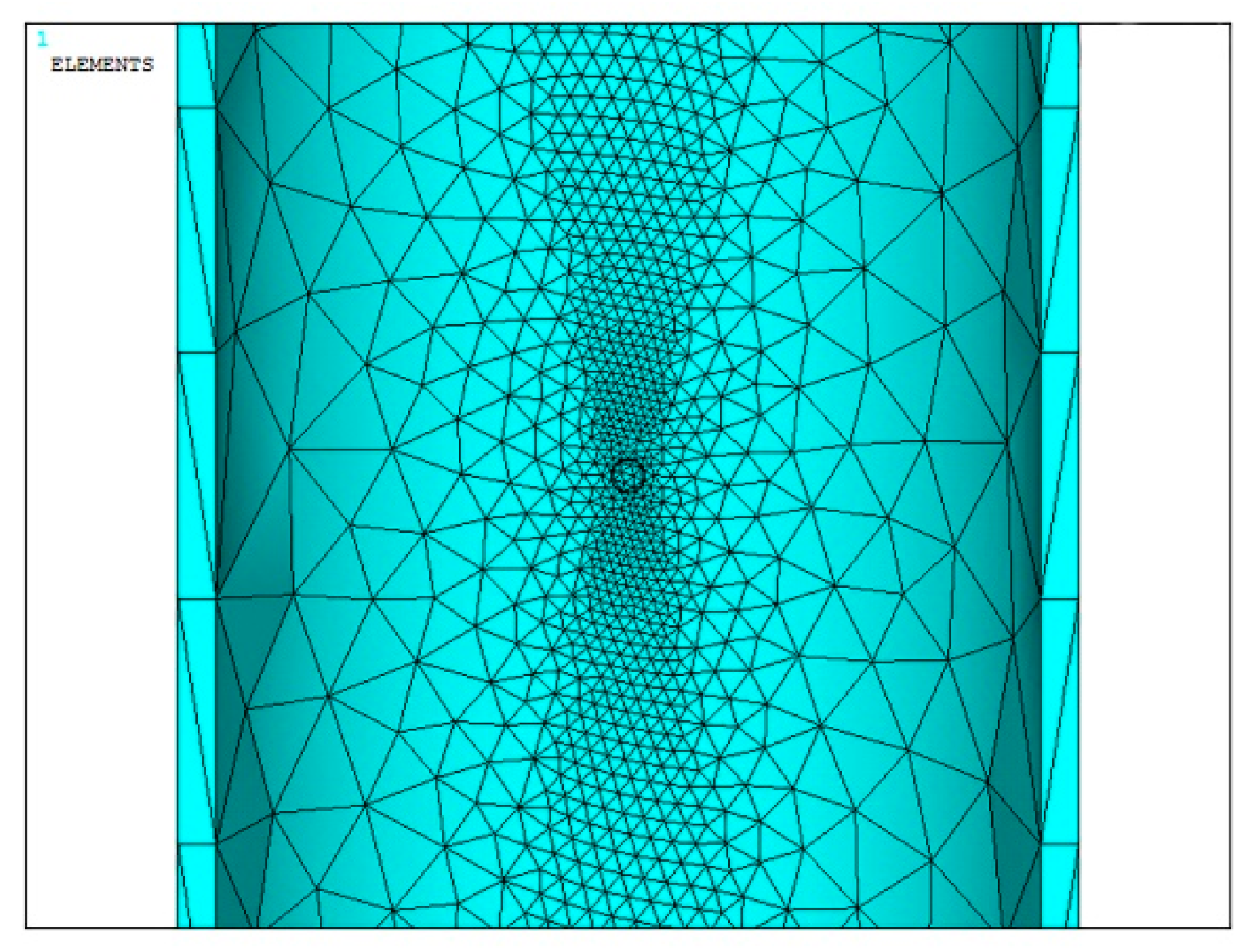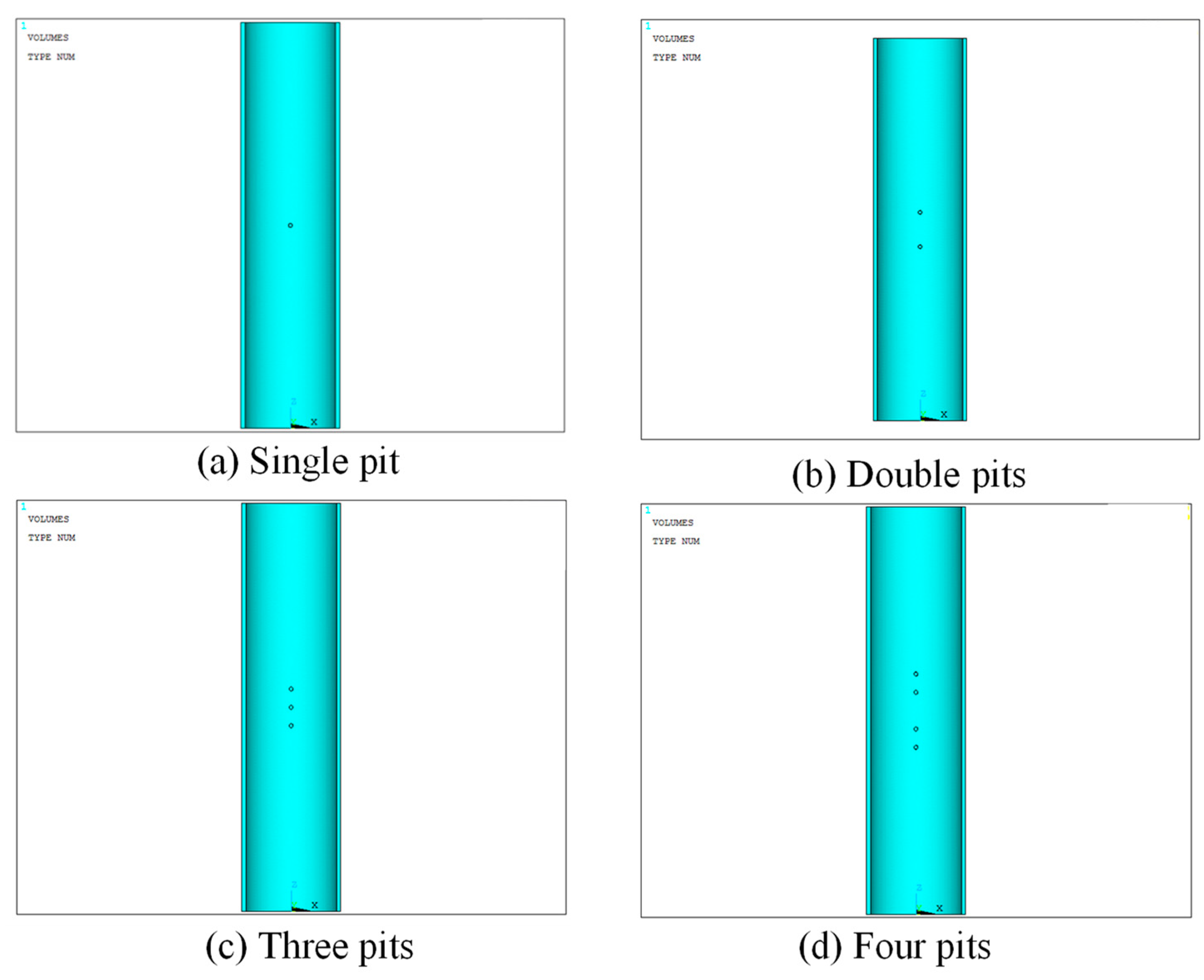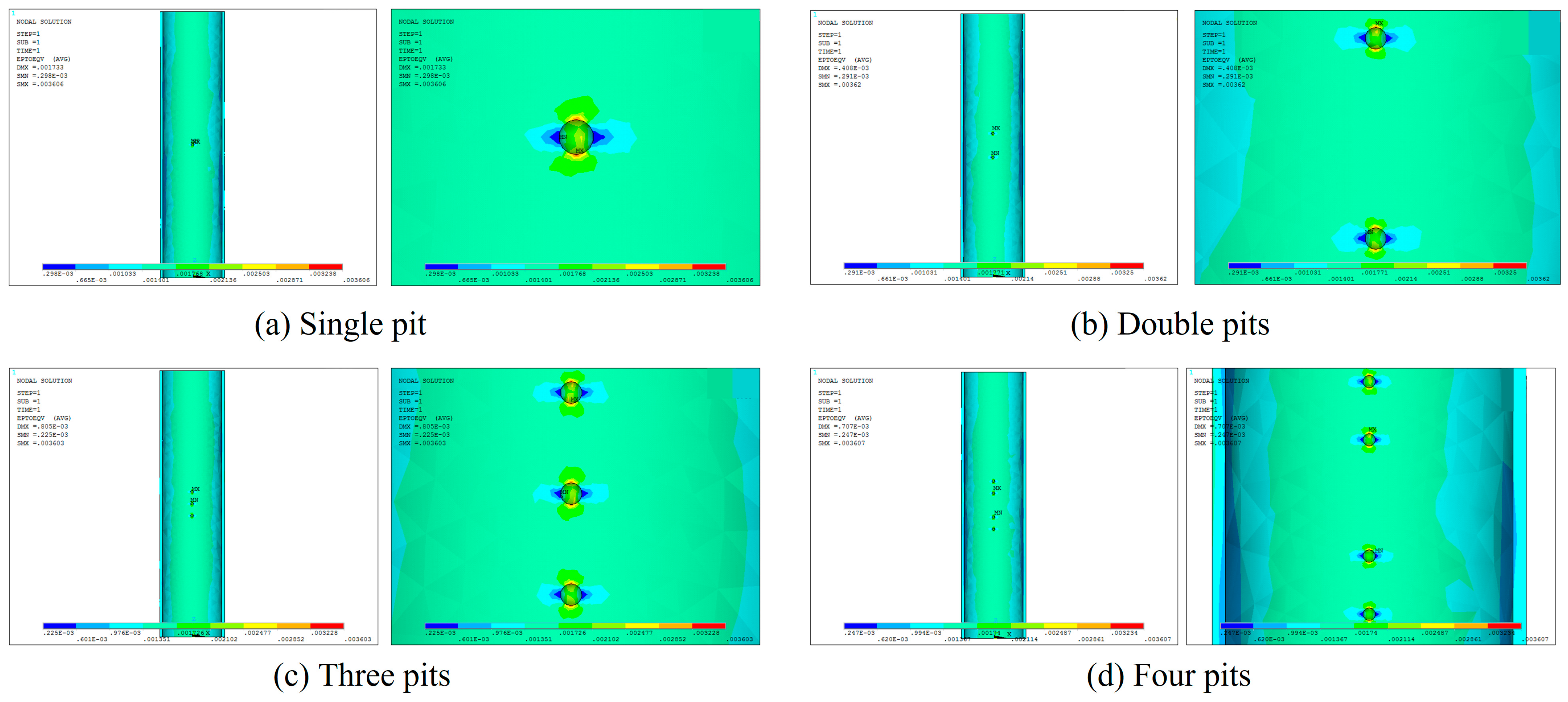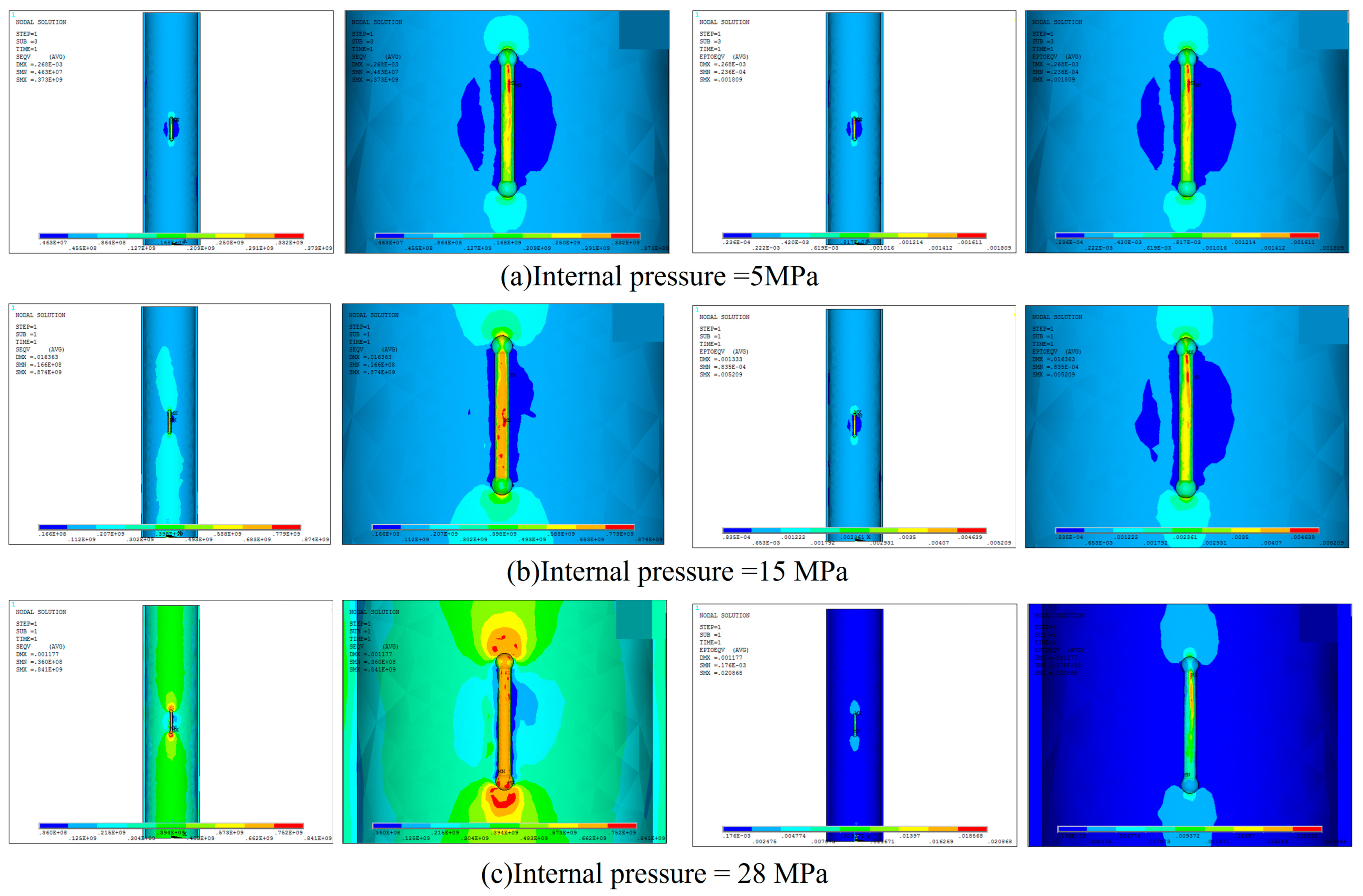Pitting and Strip Corrosion Influence on Casing Strength of Salt Cavern Compressed Air Energy Storage
Abstract
:1. Introduction

2. Failure Criterion
3. Strength Analysis of Corroded Casing under Internal Pressure
3.1. Strength Analysis of Casing with Pitting Corrosion Defects
3.1.1. Finite Element Model
3.1.2. Calculation Results and Analysis
- The effect of pitting corrosion depth
- The effect of pits number
3.2. Strength Analysis of Casing with Strip Corrosion
3.2.1. Finite Element Model of Strip Corrosion
3.2.2. Calculation Results and Analysis
- The effect of strip corrosion depth.
- Effect of axial length of strip corrosion.
4. Conclusions
Author Contributions
Funding
Data Availability Statement
Conflicts of Interest
References
- Alirahmi, S.M.; Razmi, A.R.; Arabkoohsar, A. Comprehensive assessment and multi-objective optimization of a green concept based on a combination of hydrogen and compressed air energy storage (CAES) systems. Renew. Sustain. Energy Rev. 2021, 142, 110850. [Google Scholar] [CrossRef]
- Chen, L.; Zheng, T.; Mei, S.; Xue, X.; Liu, B.; Lu, Q. Review and prospect of compressed air energy storage system. J. Mod. Power Syst. Clean Energy 2016, 4, 529–541. [Google Scholar] [CrossRef] [Green Version]
- Pottie, D.; Cardenas, B.; Garvey, S.; Rouse, J.; Hough, E.; Bagdanavicius, A.; Barbour, E. Comparative Analysis of Isochoric and Isobaric Adiabatic Compressed Air Energy Storage. Energies 2023, 16, 2646. [Google Scholar] [CrossRef]
- Li, N.; Zhao, Y.; Wang, T.; Yang, C. Trends Observation: Strategy and Development of lnternational Salt Cavern Energy Storage Research. Bull. Chin. Acad. Sci. 2021, 36, 1248–1252. [Google Scholar]
- Li, J.; Wan, J.; Liu, H.; Jurado, M.J.; He, Y.; Yuan, G.; Xia, Y. Stability Analysis of a Typical Salt Cavern Gas Storage in the Jintan Area of China. Energies 2022, 15, 4167. [Google Scholar] [CrossRef]
- Wang, G.; Zhang, X.; Li, Z.; Li, Q.; Han, Y.; Xue, X.; Mei, S. Thermodynamics analysis of salt cavern for compressed air energy storage system. Renew. Energy Resour. 2019, 37, 618–624. [Google Scholar]
- Ban, F.; Yuan, G.; Wan, J.; Peng, T. The optimum interwell distance analysis of two-well-horizontal salt cavern construction. Energy Sources Part A Recover. Util. Environ. Eff. 2021, 43, 3082–3100. [Google Scholar] [CrossRef]
- Peng, T.; Wan, J.; Liu, W.; Li, J.; Xia, Y.; Yuan, G.; Jurado, M.J.; Fu, P.; He, Y.; Liu, H. Choice of hydrogen energy storage in salt caverns and horizontal cavern construction technology. J. Energy Storage 2023, 60, 106489. [Google Scholar] [CrossRef]
- Wan, J.; Peng, T.; Yuan, G.; Ban, F.; Jurado, M.J.; Xia, Y. Influence of tubing/oil-blanket lifting on construction and geometries of two-well-horizontal salt caverns. Tunn. Undergr. Space Technol. 2020, 108, 103688. [Google Scholar] [CrossRef]
- Sun, X.; Gui, Z.; Zhang, X.; Li, Y.; Li, X.; Xu, Y.; Wang, W.; Zhou, J.; Chen, H. Research Progress on Compressed Air Energy Storage Coupled with Renewable Energy. Proc. CSEE 2023, 43, 1–20. [Google Scholar]
- Li, J.; Wan, J.; Wang, T.; Yuan, G.; Jurado, M.J.; He, Q. Leakage simulation and acoustic characteristics based on acoustic logging by ultrasonic detection. Adv. Geo-Energy Res. 2022, 6, 181–191. [Google Scholar] [CrossRef]
- Wan, J.; Peng, T.; Shen, R.; Jurado, M.J. Numerical model and program development of TWH salt cavern construction for UGS. J. Pet. Sci. Eng. 2019, 179, 930–940. [Google Scholar] [CrossRef] [Green Version]
- Wan, J.; Peng, T.; Jurado, M.J.; Shen, R.; Yuan, G.; Ban, F. The influence of the water injection method on two-well-horizontal salt cavern construction. J. Pet. Sci. Eng. 2020, 184, 106560. [Google Scholar] [CrossRef]
- Li, J.; Wan, J.; Liu, H.; Yi, X.; He, Y.; Chen, K.; Zhao, X. Numerical Study of Casing Microleakage Flow Field Sensitivity and Acoustic Field Characteristics. Materials 2023, 16, 386. [Google Scholar] [CrossRef] [PubMed]
- El Wanees, S.A.; Radwan, A.B.; Alsharif, M.; El Haleem, S.A. Initiation and inhibition of pitting corrosion on reinforcing steel under natural corrosion conditions. Mater. Chem. Phys. 2017, 190, 79–95. [Google Scholar] [CrossRef]
- Dong, S.; Fang, T.; Wan, J.; Hu, X.; Li, J.; Liu, H.; Li, D.; Qiao, S. Study on the Effect of the Water Injection Rate on the Cavern Leaching Strings of Salt Cavern Gas Storages. Energies 2023, 16, 344. [Google Scholar] [CrossRef]
- Shi, X.; Chen, P.; Xu, J.; Jiang, Z.; Nie, R.; Qing, X.; Wang, D.; Zhao, D. Analysis on Residual Strength of CO2 Tubercular Corrosion for Casings of Oil/Gas Wells. Nat. Gas Ind. 2006, 26, 95–97. [Google Scholar]
- Che, Z.; Zhang, Z.; Chen, S. Analysis on the influence of corrosion on casing strength in acidic gas field development. Oil Drill. Prod. Technol. 2012, 34, 114–118. [Google Scholar]
- Wang, M.; Zhang, Z.; Zeng, D.; Shi, T.; Shao, L. An experimental study on casing corrosion in a high-H_2S gas field. Nat. Gas Ind. 2011, 31, 85–87+140–141. [Google Scholar]
- Nabipour, A.; Joodi, B.; Sarmadivaleh, M. Finite Element Simulation of Downhole Stresses in Deep Gas Wells Cements. In Proceedings of the SPE Deep Gas Conference and Exhibition, Manama, Bahrain, 24–26 January 2010. [Google Scholar]
- Zhu, X.; Luo, S. The Regularization of Casing Corrosion Defects and Collapse Strength Analysis. Sci. Technol. Eng. 2017, 17, 193–198. [Google Scholar]
- Lian, Z.; Luo, Z.; Yu, H.; Liu, Y.; He, Y. Strength assessment of casing with corrosion pit defects. J. Southwest Pet. Univ. (Nat. Sci. Ed.) 2018, 40, 159–168. [Google Scholar]
- Huang, X.; Mihsein, M.; Kibble, K.; Hall, R. Collapse strength analysis of casing design using finite element method. Int. J. Press. Vessel. Pip. 2000, 77, 359–367. [Google Scholar] [CrossRef]














| Diameter (mm) | Wall Thickness (mm) | Elastic Modulus (GPa) | Poisson Ratio | Yield Limit (MPa) |
|---|---|---|---|---|
| 244.48 | 10.36 | 206 | 0.3 | 689 |
| Pitting Corrosion Depth (mm) | Residual Wall Thickness (mm) | Fracturing Pressure (MPa) |
|---|---|---|
| 2 | 8.36 | 18.5 |
| 3 | 7.36 | 21.6 |
| 4 | 6.36 | 22.54 |
| 5 | 5.36 | 21.70 |
| 6 | 4.36 | 22.2 |
| 7 | 3.36 | 24.37 |
| 8 | 2.36 | 21.45 |
| Number of Pits | Fracture Pressure (MPa) |
|---|---|
| 1 | 21.70 |
| 2 | 21.15 |
| 3 | 21.54 |
| 4 | 20.98 |
| Corrosion Pitting Depth (mm) | Residual Wall Thickness (mm) | Fracture Pressure (MPa) |
|---|---|---|
| 2 | 8.36 | 30.52 |
| 3 | 7.36 | 30.5 |
| 4 | 6.36 | 29.12 |
| 5 | 5.36 | 28 |
| 6 | 4.36 | 25.28 |
| 7 | 3.36 | 23.8 |
| 8 | 2.36 | 19.98 |
Disclaimer/Publisher’s Note: The statements, opinions and data contained in all publications are solely those of the individual author(s) and contributor(s) and not of MDPI and/or the editor(s). MDPI and/or the editor(s) disclaim responsibility for any injury to people or property resulting from any ideas, methods, instructions or products referred to in the content. |
© 2023 by the authors. Licensee MDPI, Basel, Switzerland. This article is an open access article distributed under the terms and conditions of the Creative Commons Attribution (CC BY) license (https://creativecommons.org/licenses/by/4.0/).
Share and Cite
Wan, J.; Ji, W.; He, Y.; Li, J.; Gao, Y. Pitting and Strip Corrosion Influence on Casing Strength of Salt Cavern Compressed Air Energy Storage. Energies 2023, 16, 5362. https://doi.org/10.3390/en16145362
Wan J, Ji W, He Y, Li J, Gao Y. Pitting and Strip Corrosion Influence on Casing Strength of Salt Cavern Compressed Air Energy Storage. Energies. 2023; 16(14):5362. https://doi.org/10.3390/en16145362
Chicago/Turabian StyleWan, Jifang, Wendong Ji, Yuxian He, Jingcui Li, and Ye Gao. 2023. "Pitting and Strip Corrosion Influence on Casing Strength of Salt Cavern Compressed Air Energy Storage" Energies 16, no. 14: 5362. https://doi.org/10.3390/en16145362





